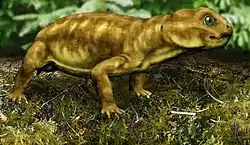1917 in paleontology
Paleontology or palaeontology is the study of prehistoric life forms on Earth through the examination of plant and animal fossils.[1] This includes the study of body fossils, tracks (ichnites), burrows, cast-off parts, fossilised feces (coprolites), palynomorphs and chemical residues. Because humans have encountered fossils for millennia, paleontology has a long history both before and after becoming formalized as a science. This article records significant discoveries and events related to paleontology that occurred or were published in the year 1917.
| |||
|---|---|---|---|
Institutions and organizations
Scientific advances
Invertebrate paleozoology
| Prehistoric insects described in 1917 | ||||||||
|---|---|---|---|---|---|---|---|---|
| Name | Novelty | Status | Authors | Age | Unit | Location | Notes | Images |
|
sp. nov |
valid |
A torticid moth |
||||||
Vertebrate paleozoology
| Non-mammalian synapsids described in 1917 | ||||||||
|---|---|---|---|---|---|---|---|---|
| Name | Status | Authors | Age | Location | Notes | Images | ||
|
Valid |
Haughton | 250 Millions years ago | The Mice lizard. | |||||
| Platycraniellus | Valid | Van Hoepen | 250 Millions years ago | |||||
|
Valid |
Haughton | |||||||
Data courtesy of George Olshevsky's dinosaur genera list.[3]
| Prehistoric dinosaurs described in 1917 | ||||||||
|---|---|---|---|---|---|---|---|---|
| Name | Novelty | Status | Authors | Age | Unit | Location | Notes | Images |
|
gen. nov |
|
Junior synonym of Archaeopteryx. Non-dinosaurian bird. |
||||||
|
gen et sp nov |
early Maastrichtian |
Junior synonym of Hypacrosaurus. |
||||||
|
gen et sp nov |
Valid taxon |
late Campanian-late Maastrichtian |
Horseshoe Canyon Formation |
|||||
Law and politics
Ethics and practice
People
Awards and recognition
Popular culture
Literature
- Hunting Dinosaurs in the Badlands of the Red Deer River Valley, Alberta by C. H. Sternberg was published. Although the work over all was non-fiction, it concluded with a series of fictional chapters wherein Sternberg dreamt of traveling back in time to the various ages of prehistory.[7]
See also
References
- Gini-Newman, Garfield; Graham, Elizabeth (2001). Echoes from the past: world history to the 16th century. Toronto: McGraw-Hill Ryerson Ltd. ISBN 9780070887398. OCLC 46769716.
- Cockerell, T. D. A. (1907). "A fossil tortricid moth". Canadian Entomologist. 39 (12): 416. doi:10.4039/ent39416-12.
- Olshevsky, George. "Dinogeorge's Dinosaur Genera List". Retrieved 2008-08-07.
- Petronievics, B. and A.S. Woodward. 1917. On the pectoral and pelvic arches of the Britt.Mus. specimen of Archaeopteryx. Proc. Zool. Soc. London: pp. 1 - 16.
- Lambe, L.M. 1917. On Cheneosaurus tolmanensis, a new genus and species of trachodont dinosaur from the Edmonton Cretaceous of Alberta. Ottawa Nat. 30: pp. 117- 123.
- Lambe, L.M. 1917. A new genus and species of crestless hadrosaur from the Edmonton Formation of Alberta. Ottawa Nat. 31: pp. 65-73.
- Sarjeant, W. A. S., 2001, Dinosaurs in fiction: In: Mesozoic Vertebrate Life, edited by Tanke, D. H., and Carpenter, K., Indiana University Press, pp. 504-529.

